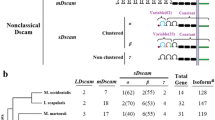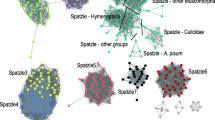Abstract
Leucine-rich repeats (LRRs) and immunoglobulin (Ig) domains represent two of the most abundant sequence elements in metazoan proteomes. Despite this prevalence, comparatively few molecules containing both LRR and Ig (LIG) modules exist, and fewer still have been functionally defined. One LIG whose function has been investigated is the Drosophila protein Kekkon1 (Kek1). In vivo studies have demonstrated a role for Kek1 in Epidermal Growth Factor Receptor (EGFR) signaling and have suggested a role in neuronal pathfinding. Kek1 is the founding member of the Kek family, a group of six Drosophila transmembrane proteins that contain seven LRRs and a single Ig in their extracellular domains. While this arrangement of domains predicts a possible role as cell adhesion molecules (CAMs), to date little is known about the function or evolutionary relationship of these additional Kek molecules. Here we report that orthologs of Kek1, Kek2, Kek5, and Kek6 exist in the mosquito, Anopheles gambiae, and the honeybee, Apis mellifera, indicating that this family has been conserved for ~300 million years of evolutionary time. Comparative sequence analyses reveal remarkable identity among these orthologs, primarily in their extracellular regions. In contrast, the intracellular regions are more divergent, exhibiting only small pockets of conservation. In addition, we provide support for the general notion that these molecules may share common functions as CAMs, by demonstrating that Kek family members can form homotypic and heterotypic complexes.





Similar content being viewed by others
References
Alvarado D, Rice AH, Duffy JB (2004a) Knockouts of Kekkon1 define sequence elements essential for Drosophila EGFR inhibition. Genetics 166:201–211
Alvarado D, Rice AH, Duffy JB (2004b) Bipartite inhibition of Drosophila Epidermal Growth Factor Receptor by the extracellular and transmembrane domains of Kekkon1. Genetics 167:187–202
Derheimer FA, MacLaren CM, Weasner BP, Alvarado D, Duffy JB (2004) Conservation of an inhibitor of the epidermal growth factor receptor, Kekkon1, in dipterans. Genetics 166:213–224
Ghiglione C, Carraway KL III, Amundadottir LT, Boswell RE, Perrimon N, Duffy JB (1999) The transmembrane molecule kekkon 1 acts in a feedback loop to negatively regulate the activity of the Drosophila EGF receptor during oogenesis. Cell 96:847–856
Ghiglione C, Amundadottir L, Andresdottir M, Bilder D, Diamonti JA, Noselli S, Perrimon N, Carraway IK (2003) Mechanism of inhibition of the Drosophila and mammalian EGF receptors by the transmembrane protein Kekkon 1. Development 130:4483–4493
Goodman CS (1996) Mechanisms and molecules that control growth cone guidance. Annu Rev Neurosci 19:341–377
Holt RA, Subramanian GM, Halpern A, Sutton GG, Charlab R, Nusskern DR, Wincker P, Clark AG, Ribeiro JM, Wides R et al (2002) The genome sequence of the malaria mosquito Anopheles gambiae. Science 298:129–149
Klueg KM, Alvarado D, Muskavitch MA, Duffy JB (2002) Creation of a GAL4/UAS-coupled inducible gene expression system for use in Drosophila cultured cell lines. Genesis 34:119–122
Kobe B, Kajava AV (2001) The leucine-rich repeat as a protein recognition motif. Curr Opin Struct Biol 11:725–732
Kuja-Panula J, Kiiltomaki M, Yamashiro T, Rouhiainen A, Rauvala H (2003) AMIGO, a transmembrane protein implicated in axon tract development, defines a novel protein family with leucine-rich repeats. J Cell Biol 160:963–973
Musacchio M, Perrimon N (1996) The Drosophila kekkon genes: novel members of both the leucine-rich repeat and immunoglobulin superfamilies expressed in the CNS. Dev Biol 178:63–76
Ono T, Sekino-Suzuki N, Kikkawa Y, Yonekawa H, Kawashima S (2003) Alivin 1, a novel neuronal activity-dependent gene, inhibits apoptosis and promotes survival of cerebellar granule neurons. J Neurosci 23:5887–5896
Pruess M, Fleischmann W, Kanapin A, Karavidopoulou Y, Kersey P, Kriventseva E, Mittard V, Mulder N, Phan I, Servant F et al (2003) The proteome analysis database: a tool for the in silico analysis of whole proteomes. Nucleic Acids Res 31:414–417
Speicher S, Garcia-Alonso L, Carmena A, Martin-Bermudo MD, de la Escalera S, Jimenez F (1998) Neurotactin functions in concert with other identified CAMs in growth cone guidance in Drosophila. Neuron 20:221–233
Swofford DL (2000) PAUP*: phylogenetic analysis using parsimony and other methods (software). Sinauer, Sunderland, Mass.
Acknowledgements
We are indebted to George Hegeman for providing us with Apis samples and thank Gene Robinson for assistance in obtaining the Apis kek6 cDNA clone. This work was supported by NIH Genetics training grant fellowship (GM07757) to C.M., D.A. and T.E., and by the National Science Foundation (IBN-0131707) to J.B.D.
Author information
Authors and Affiliations
Corresponding author
Additional information
Edited by D. Tautz
Christina M. MacLaren, Timothy A. Evans and Diego Alvarado contributed equally to this work
Rights and permissions
About this article
Cite this article
MacLaren, C.M., Evans, T.A., Alvarado, D. et al. Comparative analysis of the Kekkon molecules, related members of the LIG superfamily. Dev Genes Evol 214, 360–366 (2004). https://doi.org/10.1007/s00427-004-0414-4
Received:
Accepted:
Published:
Issue Date:
DOI: https://doi.org/10.1007/s00427-004-0414-4




